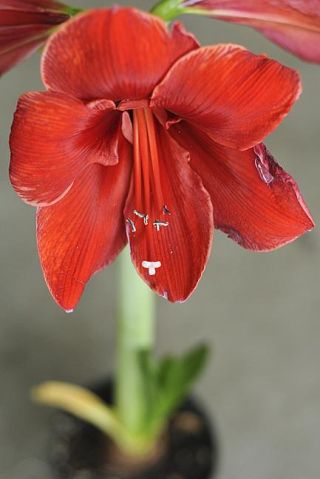Wow! The Amaryllis you got for Christmas was just beautiful, but now the flowers have shriveled. What should you do now? You can, of course, just toss the whole thing, but with care it will bloom again for several years.
These plants need about five leaves to re-bloom. They are tropical plants and need to go dormant to get enough energy for flowering again. After the flowers wither, cut at the point where they join the stem, but let the leaves and stalk remain. Water them from the bottom about once a week, pouring out any water in the saucer after an hour. It is better to under water than over water.
Keep them growing at 65 to 75 degrees in a sunny window through spring. During May (when nights are above 50 degrees), begin to transition the plant from the house to outdoors, bringing it in at night until it is acclimatized. Start first in a shaded area and move it slowly into brighter areas until it is in full morning sun when the nights are consistently warm. The leaves should be in afternoon shade for the summer.
Watch nighttime temperatures and bring the pot indoors as soon as the temperature dips below 50 degrees. About this time, withhold water letting the leaves die down. Store the bulb at 50 to 55 degrees in a dimly lit or dark area. Let the bulb rest for about six to 10 weeks. Then water the pot thoroughly so that the soil is saturated, but drain well. When the first green leaves start to show, commence watering weekly.
During dormancy, check that the pot is big enough for growth and re-bloom. These are plants that like to be crowded, so be sure not to choose a pot that is too large, either. Ideally it should be about one inch larger on each side than the widest part of the bulb. A six-inch bulb needs no larger than an eight-inch pot, and a four-inch bulb no larger than a six-inch pot.
Soak only the roots of the bulb for two to three hours in cool water. Use a fast-draining potting soil, such as for cactus, mixed about 50-50 with a fertilizer-enhanced potting soil. Put about an inch of the soil mix in the bottom of the pot and add one teaspoonful of bone meal, then add another inch or so of soil. Place the bulb in the pot so that the neck and shoulder of the bulb will be above the soil line. Fill to the top of the pot with the soil mix and place a support stick next to the flower stalk when it emerges later. Water well, remembering to drain.
When the bud appears, it will grow amazingly fast. The support stick will help keep the stem from snapping. Tie the stalk lightly to the stick with twist ties, being sure not to pinch the stalk. Once the flower opens, keep the flowering bulb in a cooler room or in a cooler part of a room, ideally at about 65 degrees. Heat and too much light will hasten the wilting of the blossom. Keep in mind that the pollen will stain, so a plate or platter will protect fabrics.
Soon, the flower will fade and it is time to start all over again. A feeding of fish fertilizer or fertilizer sticks for flowering plants will be just what it needs. The plant will not have to be re-potted again for several years and will divide, giving a free bonus, with loving care.
Linda Stephens-Urbaniak can be reached at Lindagardenlady@speakeasy.net.



